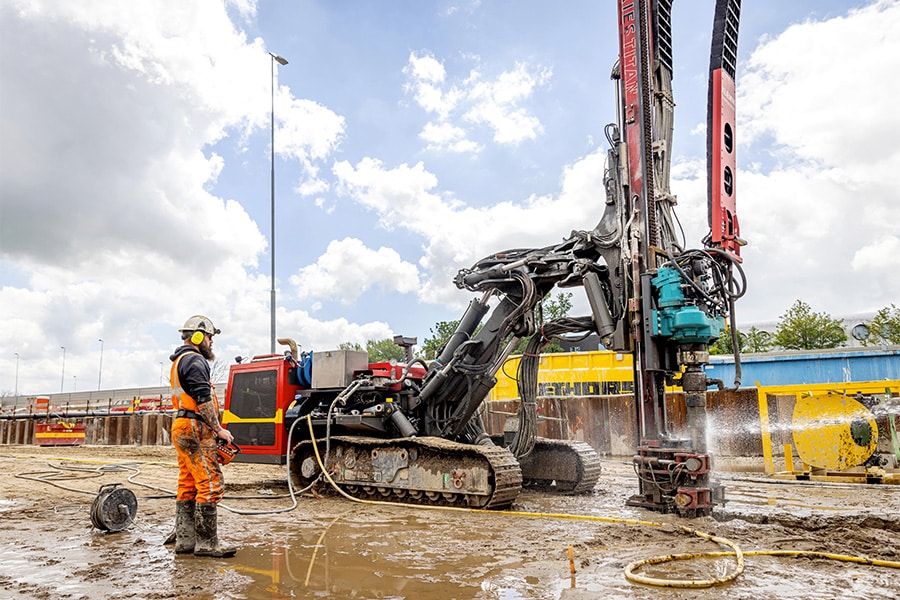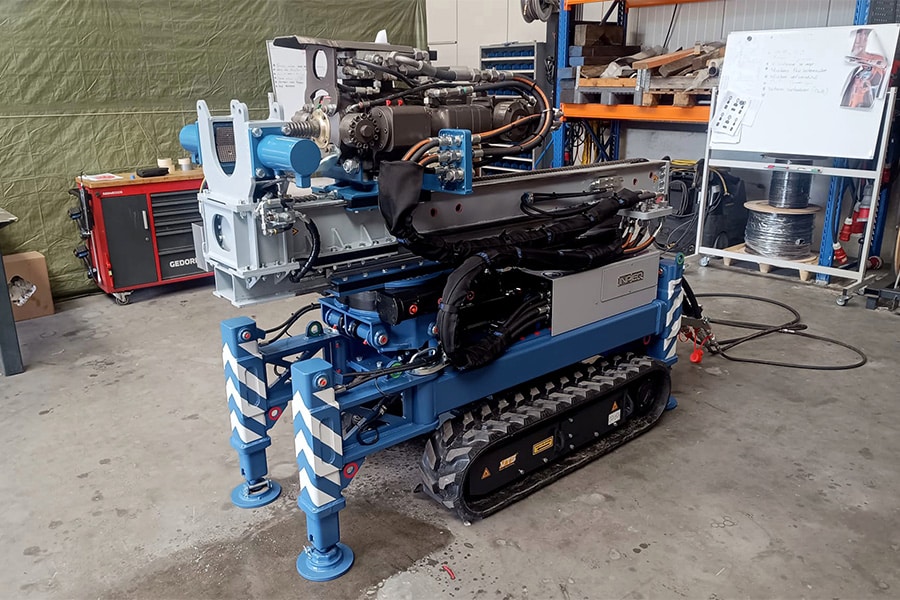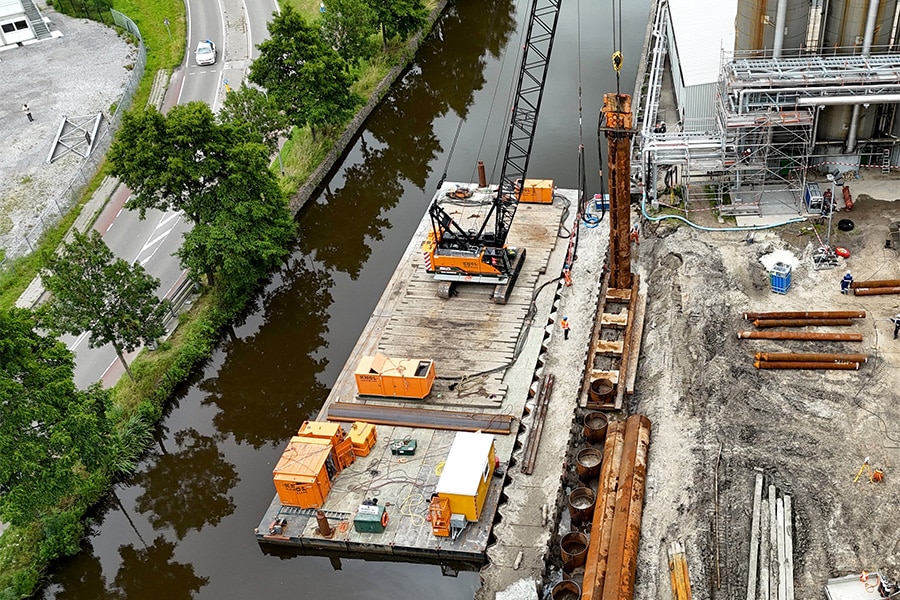
Reuse of foundation piles pays off
During reconstruction, expansion or transformation of existing structures into complete new buildings, the question is increasingly being asked whether the prefabricated pile foundation already in place can be (partially) reused. Every pile that does not have to be installed produces savings in concrete, reinforcement, transport (which, among other things, also reduces CO2 reduction) and installation: thus time and money. Fugro, together with Van der Vorm Engineering, recently proved that reusing foundation piles pays off at The Frame Building in Amsterdam. A sustainable methodology that can also be relevant for building and infrastructure works, such as quay walls and bridges.
Especially in urban areas, space is limited. Often existing structures are (partially) demolished to make way for new construction. "When demolishing them, it can be a consideration to integrate the old foundation piles into the new foundation design," says Maarten Profittlich, Manager at Fugro. "Especially when it comes to foundations with concrete piles from the 1970s or younger. From that time on, information was increasingly well documented. Think of things like the quality of the piles, the depth applied, thickness, etc.
When we get this information above water, it is a waste not to use existing foundation piles (if usable), because they are generally left in the subsurface anyway. Pile pulling is generally "not done. This is because a waterway is created upward, where in the worst case you get a fountain of (brackish) water as a gift after pulling the pile in the deep polders. For this reason, water boards often do not issue permits to pull piles, and/or mitigation measures must be taken."

Measuring factor
In the context of sustainable redevelopment, there is a demand for the reuse of an existing foundation. "More and more clients are asking about it. Obviously also because it saves time and money. That's how honest we have to be," observes Sjors Sligman, general manager at Van der Vorm Engineering, an independent consulting firm in structural engineering. "The reuse of materials and in this case foundation piles can be very interesting. And increasingly it is succeeding, because there is more and more knowledge and more research into it. Together with Fugro, we have already been able to successfully calculate various projects in this way. The foundation is often the determining factor for a new object or building. If you design a new object whose supporting structure does not match the 'old' foundation and you insist on using the existing piles, it becomes an expensive exercise and you hit the nail on the head. In other words, reusing the existing foundation is interesting, but it has to fit."

Monitoring techniques
At The Frame Building in Amsterdam, Van der Vorm Engineering faced a difficult task. The old building at this location had to make way for new construction (partially) over the neighbor's existing building. "The initial idea was that we would build on top of the existing building with the new design," Sligman explains. "From Fugro's calculations, that turned out to be neither feasible nor, more importantly, desirable, because a large number of additional structures would then have to be put through the existing building. In order to realize the design, the existing building had to be demolished and a new foundation constructed. Because of our combined experience on previous projects, we did investigate whether we could integrate the existing foundation piles into the new foundation design." Using archival data and on-site surveys, Fugro mapped and calculated the existing foundation. "Often additional concrete engineering research is also needed," Profittlich acknowledges. "Then we employ monitoring techniques such as 'hammer tap' and/or digging the existing pile free for a quality inspection. And if there is no archival data at all, then a magnetometer probe next to the pile provides insight into the length."

Standards
Foundations from the 1960s and 1970s were calculated to different standards than what current foundation design must meet. "The current NEN 9997-1 'Geotechnical Design of Structures' did not exist at that time, which incidentally reduced the pile factors (read: pile bearing capacity) some years ago. Neither did NEN 8707, which gives instructions on how to deal with loads and bearing capacity of existing piles; both geotechnical and structural," Profittlich explains. "The latter standard assumes that a test load has already taken place. After all, the building above it has been there for years. And that therefore a slightly lower level of safety may be taken into account or, in other words, slightly more load bearing capacity can be extracted." According to Sligman, the latter is fodder for discussion by the competent authority. "Because on the one hand we are calculating with the current low load factors, but we do maintain the pile bearing capacity."

Uneven settlement behavior
The existing foundation under The Frame Building consists of precast piles, while the new foundation is grafted on screw combi piles with very different properties. That combined with the knowledge that the precast piles have already been loaded in their previous life or "worse" were only partially loaded in the old situation and will be fully loaded in the final situation makes the foundation design quite complex. "Due to the combination of existing and new piles, we have to take into account uneven settlement behavior of the foundation," said Ammar Yassiri, structural engineer at Van der Vorm Engineering. "We calculated eight different configurations in which the foundation design was modeled in such a way that in none of the situations did we exceed the bearing capacity based on the settlement behavior that Fugro calculated for us. Underneath the demolished building, a slab foundation was eventually chosen that was considered in isolation and "independent" of the rest of the structure. Under this slab, 47 new piles were installed (Ø460/560 mm screw combi piles) and 38 piles were reused (precast 450×450 mm)."

Assuming the most favorable situation regarding the condition of the existing piles, the reuse of foundation piles at The Frame Building saved as many as 28 new foundation piles, says Yassiri. "The savings don't even include the side effects, such as the benefit of reusing existing piles in positions where a piling rig could not reach, and therefore also saving rebar." Proof that reusing piles pays off. In infrastructure, too, Fugro has already calculated on various objects. "When widening or replacing a structure, it is definitely worth investigating whether the existing foundation can be integrated into the new foundation design," Profittlich says in conclusion.
Saving on poles
Reuse of the foundation piles at The Frame Building saved between 25% and 37% on new piles of the foundation under the existing building. This does not yet take into account the benefit of reusing existing piles in positions where the pile driver could not reach, saving rebar as well as potentially providing a more sustainable solution for the surrounding area.
Heeft u vragen over dit artikel, project of product?
Neem dan rechtstreeks contact op met Fugro.
 Contact opnemen
Contact opnemen




